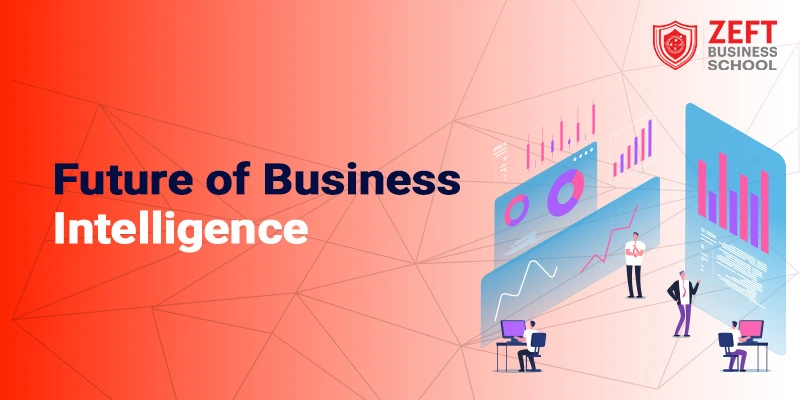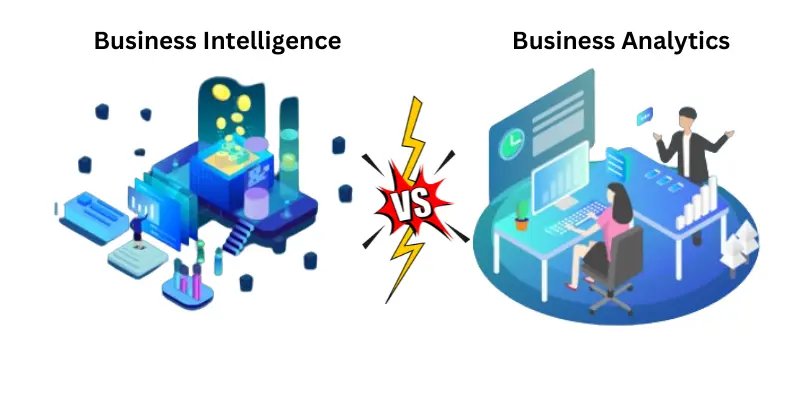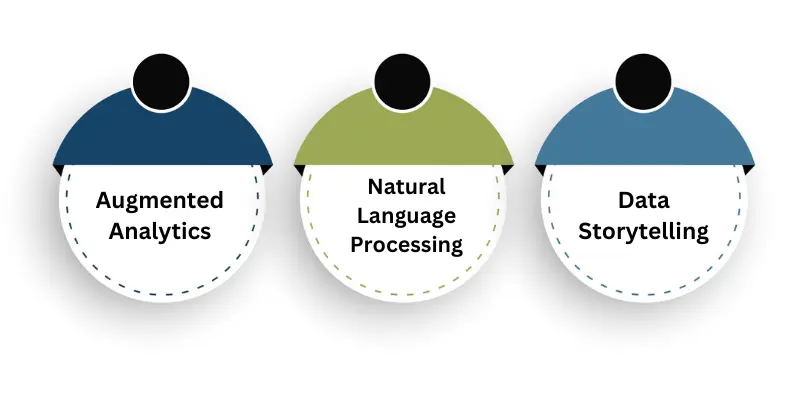The world of data is a constantly churning ocean, and the tools and techniques used to navigate it are rapidly evolving. Business analytics and business intelligence have long been the captain’s compass for organisations seeking to avoid data pitfalls and discover valuable insights. However, the future holds exciting advancements to revolutionise further how businesses leverage data for informed decision-making.
This blog delves into the key trends shaping the future of Business intelligence (BI) and Business Analytics (BA), exploring the increasing role of AI, advanced analytics techniques, data integration, and real-time analysis. We’ll also navigate the challenges and opportunities big data and data privacy regulations present.
What is Business Analytics and Business Intelligence?
In today’s data-driven world, extracting meaningful insights from vast information is crucial for effective decision-making. This is where Business Intelligence (BI) and Business Analytics (BA) play vital roles.
Business Analytics (BA)
BA goes beyond BI by leveraging historical data and advanced analytical techniques like machine learning to predict future trends or customer behaviour. It anticipates outcomes, enabling proactive decision-making.
Business Intelligence (BI)
BI analyst collects, analyses, and visualises historical data to understand current business performance and trends. It helps identify improvement areas and measures past initiatives’ success through dashboards and reports tracking key performance indicators (KPIs).
Business Intelligence vs. Business Analytics
While BI focuses on understanding the present, BA predicts the future, informing data-driven strategies. Together, they provide a comprehensive view of an organisation’s performance, empowering informed decision-making for growth and success.
The Powerhouse Duo, AI and Machine Learning in BI and BA
Traditionally, BI and BA have relied on human-driven analysis. Advancements in Machine Learning (ML) and Artificial Intelligence (AI), big data, and other emerging trends are shaping the future of BI and BA, equipping them with even more powerful tools to navigate the ever-evolving business landscape. These technologies automate tedious tasks, identify hidden patterns in data, and generate deeper insights, empowering BI analysts to become strategic partners in the decision-making process.
Here’s how AI and ML can be leveraged in both business analytics and business intelligence:
Automated Data Collection and Preparation
Tedious tasks like data cleaning and normalisation, which can consume significant analyst time, can be automated using AI and ML algorithms. This frees up BI analysts to focus on higher-level analysis and strategic problem-solving.
Advanced-Data Pattern Recognition
The human brain is powerful but can miss complex patterns buried deep within massive datasets. AI algorithms, on the other hand, excel at identifying these hidden relationships, leading to unexpected discoveries. This empowers BI Analysts to develop more comprehensive and data-driven business strategies.
Predictive Analytics
Machine learning can build robust predictive models that forecast future trends. This allows businesses to be proactive, anticipating customer churn, market fluctuations, or equipment failures before they occur. Analytics and Business intelligence dashboards can be leveraged to visualise these predictions, enabling leaders to make informed decisions based on future possibilities.
The question may arise, “Can AI replace the need for human BI Analysts? ” The answer is a resounding no. While AI automates tasks, it lacks the human ability to understand the nuances of business context and translate insights into actionable strategies. The future of BI and BA lies in a collaborative approach where AI augments human expertise. Here’s where BI analysts become even more crucial:
Developing Business Questions
AI excels at answering questions but needs help defining the right questions. BI analysts partner with stakeholders to define the most critical business questions that data analysis needs to address. These questions should be aligned with overall business goals and objectives.
Data Storytelling
In the future of business intelligence, the role of BI analysts will evolve to encompass the utilisation of AI-generated insights in crafting compelling narratives that resonate with non-technical audiences. Communicating complex data insights clearly and compellingly remains a human skill. BI analysts will use AI-generated insights to craft compelling narratives that resonate with non-technical audiences. Effective data storytelling can transform raw numbers into actionable recommendations, driving decision-makers buy-in.
As these trends gain momentum, the demand for skilled professionals translating data into actionable insights will continue to soar. An MBA in Business Analytics in Chennai can equip you with the necessary tools and knowledge to become a data-savvy leader in this ever-evolving field. This specialised program will provide a comprehensive understanding of data analysis tools, techniques, and best practices, preparing you to navigate the complexities of big data and steer your organisation towards data-driven success.
Advanced Predictive Analytics Techniques
Beyond automation, advanced analytics techniques are unlocking new possibilities for uncovering hidden patterns and predicting future outcomes.
Time Series Forecasting
This technique goes beyond simply looking at historical trends. It incorporates statistical methods to account for seasonality, cyclical patterns, and potential outliers, providing a more accurate picture of future possibilities. Business analytics and intelligence dashboards can leverage time series forecasting to predict sales figures, inventory needs, website traffic patterns, and equipment maintenance schedules. This allows businesses to prepare for fluctuations in demand and optimise resource allocation proactively.
The difference between business analytics and business intelligence becomes apparent here. BI focuses on historical data to understand current trends, while BA utilises advanced techniques like time series forecasting to predict future behaviour and customer sentiment.
Customer Churn Prediction
Losing customers is expensive, and identifying those at risk of churning is crucial for businesses to retain their customer base. Customer churn prediction models analyse customer behaviour data like purchase history, support interactions, and website activity. They can identify patterns that indicate a customer is likely to churn, allowing businesses to intervene with targeted marketing campaigns, loyalty programs, or personalised offers.
Business analytics goes beyond simply identifying at-risk customers. It helps businesses understand the “why” behind churn. By analysing churn prediction model outputs, BI analysts can uncover factors.
Poor customer service experiences, a lack of product features, or high pricing contribute to churn. Addressing these causes allows businesses to improve customer retention strategies.
Considerations: The effectiveness of churn prediction models depends on the quality and relevance of the data used. Data cleansing and feature engineering ensure the model identifies the most relevant factors influencing churn.
Sentiment Analysis
Social media has become a powerful platform for gauging public opinion. Sentiment analysis goes beyond simply counting mentions of a brand or product. It uses AI and Natural Language Processing (NLP) to understand the emotional tone of online conversations. This allows businesses to assess customer sentiment towards their brand, products, marketing campaigns, and competitor offerings.
Analytics and Business intelligence can leverage sentiment analysis to track brand perception over time and identify emerging trends in customer sentiment. This allows businesses to address negative sentiment and capitalise on positive feedback proactively.
Business analytics can use sentiment analysis to understand the “why” behind customer sentiment. By analysing the content of negative reviews or social media posts, BI analysts can identify specific pain points or areas for improvement.
Challenges: Sentiment analysis models can be susceptible to sarcasm, slang, and other nuances of human language. BI analysts must carefully evaluate the model’s outputs and combine them with qualitative data, such as customer surveys and focus groups, for a more holistic understanding of customer sentiment.
Integration of business analytics and intelligence
While BI and BA serve distinct purposes, their success hinges on seamless data integration and a unified workflow. Here’s a practical approach to achieve this for the future of Business Intelligence and Analytics:
Data Extraction, Transformation, and Loading (ETL)
A BI analyst must understand the intricacies of data storage and processing. Data resides in various formats and locations within an organisation. ETL processes, crucial for BI analysts, automate data extraction from diverse sources, loading it into a centralised data warehouse or data lake after formatting it. This strategic approach ensures BI analysts access reliable and up-to-date data, fostering a seamless workflow between BI and BA applications.
Data Visualization and Dashboard Creation
Data visualisation tools like Tableau, Power BI, and Qlik are essential for presenting historical and predictive data insights in an easily digestible format. These tools allow bi-analysts to create interactive dashboards catering to different stakeholders’ needs. For instance, a sales dashboard might focus on key performance indicators (KPIs) like sales figures, conversion rates, and regional trends. An HR dashboard might track employee engagement metrics, turnover rates, and skill gaps.
The future of Business analytics and business intelligence lies in creating user-friendly dashboards that empower stakeholders to make data-driven decisions and as the demand for data expertise surges, Top MBA B Schools in Chennai can provide a springboard for your career.
Collaboration and Communication
Business analytics and business intelligence are not siloed functions. Effective communication and collaboration between bi analysts, business stakeholders, and IT teams are crucial for successful data utilisation. Bi analysts should involve stakeholders throughout the data analysis, ensuring the chosen metrics and visualisations align with business objectives. This fosters a collaborative environment where data insights are translated into actionable strategies.
Security and Data Governance
With the integration of multiple data platforms, robust data governance and security protocols become paramount. Here are vital considerations for BI analysts in the future of BI and BA:
Data Access Control
Implementing role-based access control ensures that only authorised users can access sensitive data relevant to their job functions. This protects sensitive information and safeguards against unauthorised access.
Data Quality Management
Regular data quality checks help identify and rectify errors or inconsistencies in data, ensuring the accuracy and reliability of insights generated from business analytics and business intelligence tools.
Challenges and Opportunities of Real-Time Analytics
The ever-growing volume of data, also known as big data, presents both challenges and opportunities in the future of Business Intelligence and Business Analytics. Business analytics and intelligence dashboards traditionally focus on historical data, but real-time analytics allows for near-instantaneous insights.
Here’s how big data and real-time analytics impact BI and BA:
Challenges
Processing and analysing massive datasets in real time requires robust infrastructure and skilled professionals. Additionally, the sheer volume of data can lead to info overload, making it challenging to identify the most relevant insights. Bi analysts must develop strategies to filter and prioritise real-time data to extract the most valuable insights. Pursuing advanced education, such as an MBA from reputable institutions like MBA Colleges in Chennai, can provide individuals with the necessary expertise to navigate complex datasets and utilize real-time analytics effectively.
Opportunities
Real-time analytics enables businesses to react to changing market conditions, customer behaviour, and operational inefficiencies much faster. For example, businesses can monitor social media sentiment in real-time to address customer concerns before they escalate.
Business analytics and intelligence dashboards can be adapted to reflect real-time data for better decision-making. For instance, a logistics company can monitor real-time traffic data to optimise delivery routes and ensure on-time deliveries. On the other hand, business analytics can leverage streaming analytics to identify anomalies and potential problems in real time, enabling proactive problem-solving.
Emerging Trends in BI and BA
The future of business Intelligence is brimming with exciting possibilities. Here are a few key trends to watch that will shape the business analytics and intelligence landscape:
Augmented Analytics
This approach combines human expertise with AI-powered insights to create a more comprehensive understanding of data. BI analysts will utilise AI-generated recommendations to refine their analysis and identify the most impactful insights. This will empower them to move beyond basic reporting and uncover the “why” behind data patterns.
Natural Language Processing (NLP)
NLP will make business analytics and intelligence more accessible to non-technical users. Users can interact with data using natural language, democratising data analysis within organisations. Imagine asking a question like “What are the factors driving customer churn in the Northeast region?” and receiving a clear and concise answer with supporting data visualisations. NLP will revolutionise how businesses interact with and utilise data for informed decision-making.
Data Storytelling
As discussed previously, Communicating complex data insights clearly and compellingly will become even more critical. BI analysts must develop strong storytelling skills to engage audiences and drive data-driven decision-making. Compelling data storytelling goes beyond simply presenting charts and graphs. It involves weaving a narrative around the data, highlighting key findings and their implications for the business.
Pursuing an MBA in Business Intelligence and Analytics Management can be a strategic move if you are willing to learn how to weave big data into stories and leverage analytics effectively.
The Data Privacy Dilemma
As data becomes the lifeblood of business, data privacy regulations like GDPR and CCPA are becoming increasingly important. These regulations aim to give individuals control over their data and restrict how businesses collect and utilise it.
The future of business analytics and business intelligence needs to navigate this complex landscape. Bi analysts must ensure data collection and analysis practices comply with relevant regulations. Balancing the need for data-driven insights with data privacy will be a crucial challenge for organisations moving forward.
Here are some strategies bi analysts can employ to navigate data privacy regulations:
- Data Anonymization: Techniques like anonymisation can mask personal identifiers in data sets, allowing for analysis while protecting individual privacy.
- Data Minimization: Businesses should collect only the data necessary for specific business purposes, minimising the amount of personal data stored.
- Transparency and Consent: Companies should be transparent about collecting, using, and storing personal data. They should also obtain explicit and informed consent from individuals before using their data for business analytics and intelligence purposes.
The future of Business Intelligence and Business Analytics is dynamic, driven by advancements in AI, big data, and data privacy regulations. Bi analysts who embrace these trends and continuously develop their skill sets will be well-positioned to thrive in this evolving landscape. By leveraging AI and advanced analytics techniques, integrating business analytics and business intelligence tools, and adapting to real-time data analysis, businesses can make data-driven decisions that lead to a competitive advantage. The journey ahead requires collaboration between humans and AI, where human expertise is combined with the power of automation to unlock the true potential of data for business success. Asbusiness analytics and intelligence continue to evolve, one thing remains certain: data will be the cornerstone of informed decision-making, shaping the future of successful organisations like ZEFT Business School, which play a crucial role in educating the next generation of leaders in this field.




